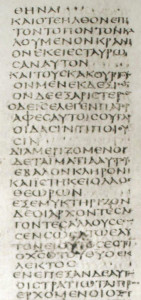The text of John 7:53 through to 8:11 is known to Biblical scholars as The pericope adulterae. Concerning this, Associate Professor of Biblical Theology at The Southern Baptist Theological Seminary writes:
Have you noticed the double brackets in the ESV that surround John 7:53–8:11 in Logos Bible Software (if available)? Those double brackets mean that the ESV’s translation committee does not consider this passage to be original to John’s Gospel. You also find double brackets around Mark 16:9–20 in Logos Bible Software (if available).
Do you know what it means that these passages are marked off–correctly–as not coming from the authors of these respective Gospels? If John did not write what is enumerated as 7:53–8:11, that means it doesn’t belong between John 7:52 in Logos Bible Software (if available) and 8:12 in Logos Bible Software (if available) because it does not come from the author who was “carried along by the Holy Spirit.” If John did not write this passage, it isn’t Scripture because it was not “breathed out by God.” If it isn’t Scripture, it shouldn’t be in the text, and pastors shouldn’t preach it.
That’s what those double brackets mean about these passages. I submit that if a translation committee has come to the conclusion that they should put double brackets around these texts, they would serve pastors and Bible teachers better by putting these texts in a footnote rather than in the text. Those double brackets are too easy not to notice. The ESV puts John 5:4O in Logos Bible Software (if available) in a footnote because the editors do not think John wrote that verse. The same should be done with Mark 16:9–20 in Logos Bible Software (if available) and John 7:53–8:11 in Logos Bible Software (if available).
What is the evidence for such a conclusion? In what follows I will only present the evidence for John 7:53–8:11 in Logos Bible Software (if available), evidence that comes from the New Testament manuscripts (external evidence) and from the flow of thought in John’s Gospel (internal evidence). [If you’re interested in the Mark 16 issue, I discussed that passage also from the pulpit].
The Manuscripts
We are dealing with books written long before the printing press and long copied by hand. John 7:53–8:11 in Logos Bible Software (if available) is not in any of the earliest manuscripts, and Bruce Metzger notes that “No Greek Church Father prior to Euthymius Zigabenus (twelfth century) comments on the passage, and Euthymius declares that the accurate copies of the Gospel do not contain it.”
That means that at some point a scribe copied this passage into a manuscript of John’s Gospel, and then that got perpetuated. The fact that we have enough evidence to determine this to be the case should increase our confidence in the text of the New Testament. That there is a consensus on this point should make us more confident in the Scriptures not less.
John 7:53–8:11 in Logos Bible Software (if available) is not in any of the best texts: P66, P75, Codex Sinaiticus, Codex Vaticanus, etc. As the note above the passage in the ESV states, the earliest manuscripts do not include it. As the footnote in the ESV text states, some manuscripts contain this passage, but not following John 7:52 in Logos Bible Software (if available). Some have it after John 7:36 in Logos Bible Software (if available) or 21:25 in Logos Bible Software (if available) or even Luke 21:38 in Logos Bible Software (if available). Again, the fact that we have enough manuscript evidence to arrive at this conclusion shows that we can be practically certain about the original contents of the text of the New Testament.
The Flow of Thought in John’s Gospel
In addition to the manuscript evidence indicating that John the author of the Gospel did not put this passage here, we can also observe that the passage interrupts the flow of thought in this section of the Gospel. The opponents of Jesus are ready to kill him (John 5:18 in Logos Bible Software (if available); 7:19–20 in Logos Bible Software (if available), 25 in Logos Bible Software (if available)). They seek to arrest him (7:30, 32), and they are frustrated when the officers don’t bring him in (7:45–47). Their minds are made up. They have just rejected Nicodemus’s counsel that they investigate Jesus (7:51). They are past the point of testing Jesus or seeking charges to bring against him, as the interpolated passage has them doing in 8:6. They do not need charges against Jesus. He has called “God his own Father, making himself equal with God” (John 5:18 in Logos Bible Software (if available)), so they can bring him up on charges of blasphemy.
There are accounts in other Gospels similar to this one about the woman caught in adultery, but there are no accounts like this one in John. The passages most similar to this interpolated passage are the ones that depict the scribes and Pharisees disputing directly with Jesus over someone who is in need. Interestingly, the two accounts closest to this one involve the healing of the paralytic and the man with the withered hand. Mark places both of those incidents (Mark 2:1–12 in Logos Bible Software (if available); 3:1–5 in Logos Bible Software (if available)) prior to the Pharisees’ fateful decision to seek to kill Jesus (Mark 3:6 in Logos Bible Software (if available)).
John Doesn’t Talk This Way
Have you noticed that John always refers to the opponents of Jesus as “the Jews”? Did you notice that John never refers to the scribes? The only instance of the word “scribes” in John’s Gospel is in the interpolated passage at 8:3. In fact there are 14 words in John 7:53–8:11 in Logos Bible Software (if available) passage that occur nowhere else in John’s Gospel.
Continuity Between John 7 and 8
If we pass over 7:53–8:11, we find that the setting and situation in the rest of John 8 matches the setting and situation of John 7. As we move to John 8:12 in Logos Bible Software (if available), John continues to present Jesus speaking at the temple (7:28; 8:20) on the last and greatest day of the feast (7:37).
Not only is the setting of John 8 the same as that of John 7, the points under discussion are the same. Jesus claimed to be the fulfillment of the water pouring ceremony of the Feast of Tabernacles in 7:37–39. That water pouring ceremony likely commemorated the water from the rock in the wilderness (Exod 17:1–7 in Logos Bible Software (if available); Num 20:2–13 in Logos Bible Software (if available)). In addition to the water pouring ceremony there was a ceremonial lighting of candles, likely commemorating the way the Lord lit Israel’s way through the wilderness by the pillar of cloud and flame. In John 8:12 in Logos Bible Software (if available), Jesus will assert that he is the light of the world. Other points of contact between John 7 and 8 include the following:
Testimony, 7:18, 28; 8:13
Where Jesus comes from and where he goes, 7:25–30, 31–36; 8:14, 21–22 (cf. esp. 7:34–35 and 8:21–22)
Righteous judgment, 7:24; 8:15
The Jews don’t know God, 7:28; 8:19, 55
The seeking of glory, 7:18; 8:50, 54
A Plea to Translation Committees
Bible translation committees responsible for the ESV, CSB, NIV, NAS, and any other translation preached from pulpits should do pastors a favor and put these texts in footnotes. Mark 16:9–20 in Logos Bible Software (if available) was not written by Mark, and John 7:53–8:11 in Logos Bible Software (if available) was not written by John. Those passages do not belong in the text and should not be preached from pulpits. The snake-handlers are woefully mistaken. They should not think there is any warrant in the New Testament for such a practice. Similarly, those who cry that no one should throw stones anytime sinners are called to repentance have misunderstood this interpolated passage (Jesus does tell the woman to stop sinning in 8:11), but still the passage has no business in the text. It was not written by John, and it should not be there interrupting the flow of though between 7:52 and 8:12. Put it in a footnote.
[it was my privilege to preach John 7:53–8:29 in Logos Bible Software (if available) at Kenwood Baptist Church today, and for any who may be interested in the way I addressed this issue from the pulpit, the sermon audio is online].




